If you are looking to do simple core workouts at home, you are in the right place. I am going to tell you two different core workouts, and explain when to do each one.
Before we jump into the specific exercises, I want to give you some more background into the difference between core workouts, ab workouts, and which is best for you.
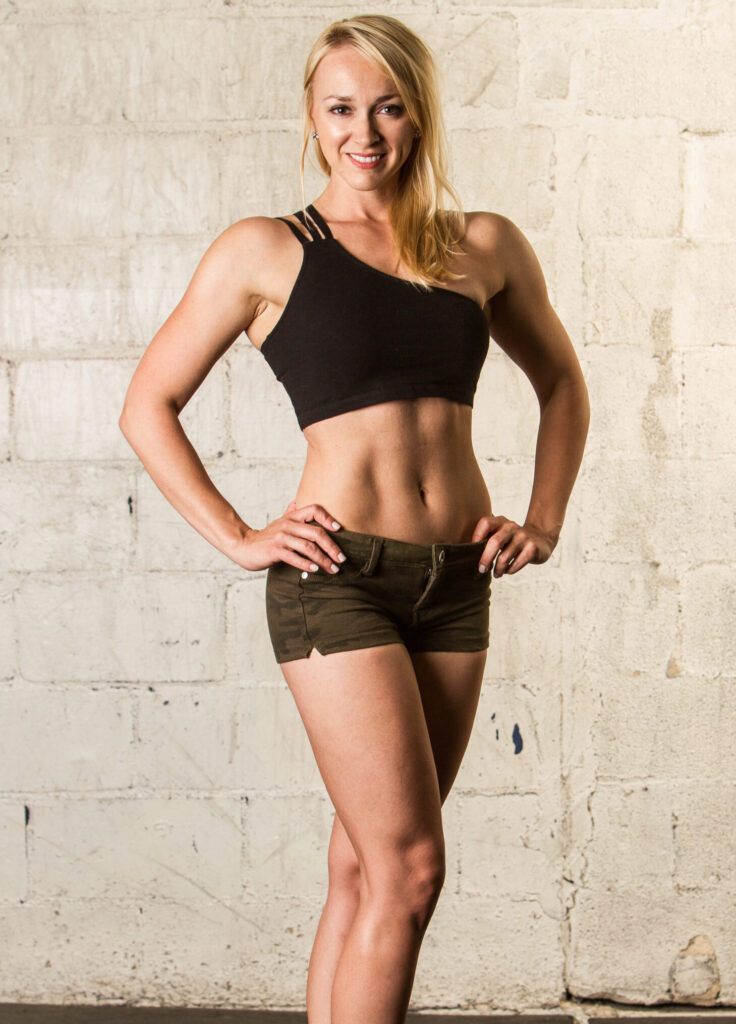
What are the Abdominal Muscles?
The abdominal muscles, also known as the abs, are a group of muscles located in the abdomen or the stomach area. They play a crucial role in providing stability and support to the trunk, facilitating movements such as bending forward, twisting, and maintaining posture. The main abdominal muscles include:
- Rectus abdominis: This is the most well-known abdominal muscle, commonly referred to as the “six-pack muscles.” It runs vertically down the front of the abdomen and is responsible for flexing the spine, usually in a straight line.
- External obliques: These muscles are located on the sides of the abdomen and run diagonally downward. They help with rotation and bending of the trunk.
- Internal obliques: Situated beneath the external obliques, these muscles also run diagonally but in the opposite direction. They work in conjunction with the external obliques to assist with trunk rotation and bending.
- Transverse abdominis: This muscle is the deepest of the abdominal muscles and wraps around the abdomen horizontally. It acts like a corset, providing stability and support to the spine and pelvis.
These muscles work together to support the abdominal wall, protect the internal organs, and assist in various movements and activities. Strengthening and conditioning the abdominal muscles can help improve core stability, posture, and overall functional movement.
What Muscles Make Up the Core Muscles?
The abdominal muscles I mentioned above make up the abs, which are on the front of your stomach. Core muscles include most of the muscles in your torso. This means core muscles include all of the abdominal muscles, but also the other muscles in your back and midsection that are in your trunk.
The core muscles work together to stabilize the spine, pelvis, and trunk, providing a solid foundation for movement and overall stability. While the abdominal muscles are a significant part of the core, other muscles also contribute to its function. In addition to the abdominal muscles listed above, muscles that make up the core include:
- Multifidus: These small muscles run along the spine and play a crucial role in stabilizing each vertebra, contributing to overall spinal stability.
- Erector spinae: A group of muscles located along the back of the spine, the erector spinae helps maintain an upright posture and assists in spinal extension and rotation.
- Quadratus lumborum: Located on either side of the lower back, these muscles help stabilize the pelvis and spine and assist in lateral flexion of the trunk.
- Pelvic floor muscles: Found at the base of the pelvis, these muscles provide support to the pelvic organs and contribute to core stability and control.
- Diaphragm: A dome-shaped muscle located beneath the lungs, the diaphragm plays a crucial role in breathing and also contributes to core stability by creating intra-abdominal pressure.
Together, these muscles work in coordination to support the spine, pelvis, and trunk during various movements and activities, providing stability, balance, and protection to the body’s core. Work both ab movements and core movements for optimal ab development and core strength.
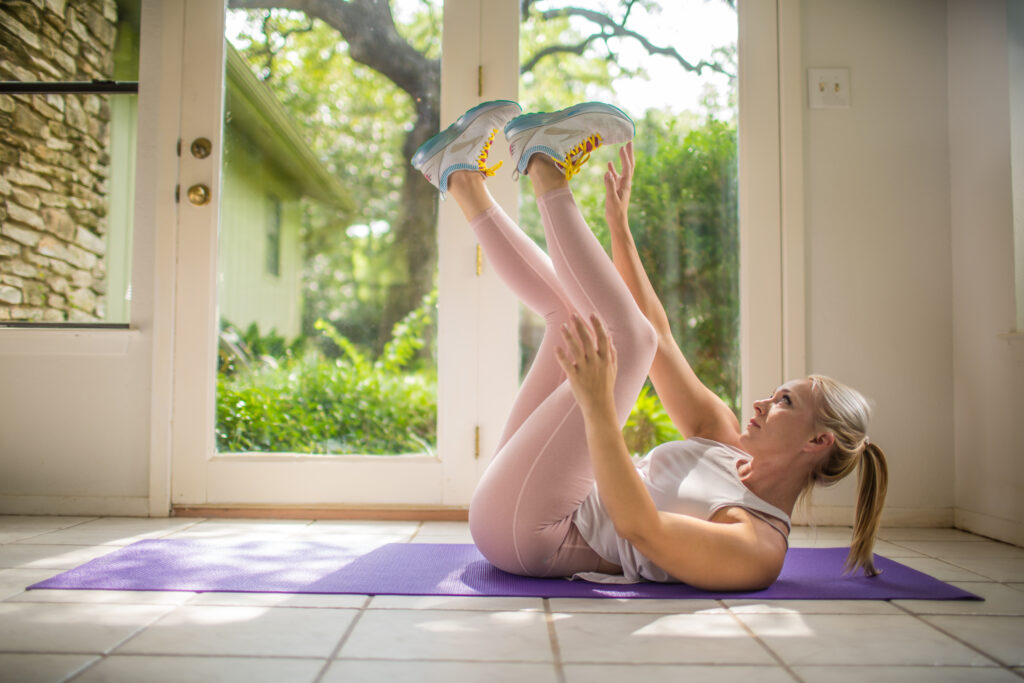
What is the Difference Between Ab Work and Core Work?
As you can see, all abdominal muscles are muscles of the core, but not all core muscles are abs. This means that an ab workout will focus more on crunches, sit ups, some twists, abdominal bracing, and many other forms of spinal flexion.
Core work includes, in addition to the above, anti-rotation, twisting, and spinal flexion and extension. Remember, core work includes many back muscles.
It is important to do both ab work, and core work. Whether your abs show or not, they are there and it’s smart to train them to be strong. The leaner you get, the more your abs will show (if you work them).
It is impossible to cleanly separate these muscles and movements though; for example, what people call lower abs often works your whole abdominal wall, and hip flexors. Planks and toros stabilization exercises work your entire core, the superficial rectus abdominis, deep transverse abdominis, and many muscles in the back. Muscles in your core even help stabilize the shoulder blades.
This is good news though! Like many exercises, we find that when trained well, they really work your entire body in a beneficial way. Training core will help with specific core strength, and whole body strength and stabilization. These simple core workouts at home make it easy to train.
So, let’s get into it. Below I have categorized these sessions into an A session, which is focused on abs, and a B session, which is a whole core session. Try these both for simple core workouts you can do at home.
A Session: An Ab Workout For Home
This session is 7 exercises. I’ll give more specific details below, but I suggest doing them as a big circuit.
Crunches
- lay on your back, supporting your head if you choose
- using your abs, think about bringing your ribs closer to your hip bones
- this is not a sit-up; it’s a partial range of motion crunch
- you can do these on the floor or on a stability ball. If you use a stability ball, Swiss ball or BOSU ball, set up with your bellybutton approximately on the top of the ball. This will be challenging but will give you the best ab workout.
Alternating Toe Touch
- lay on your back with your right leg bent and right foot on the floor
- bring your outstretched left leg up to touch your left foot with your right hand
- do all your reps on this side and then repeat on the other side
Toe Touch
- lay on your back with your legs in the air
- reach your right arm toward your left toes in a quick crunch motion
- reach your left arm toward your right toes in a quick crunch motion
- continue alternating sides
Russian Twist
- Start in situp position
- Hold your feet a few inches off the ground
- Rotate your shoulders to face your left side, then back across the midline to face the right side
- Keep your chest up and don’t let your low back sink into the floor
V Up
- from a regular seated position on the ground, hinge back while keeping your back straight
- this is crucial – no rounding in your low back!
- make a “V” shape with your upper body to hips to knees
- with your hands behind you for balance, extend this “V” as you lean back and extend your legs at the same time
- without pressing into the ground, return to your start position
Dead Bug
- lay on your back with arms and legs extended into the air
- squeeze your abs to press your back into the ground
- maintain this abdominal squeeze
- extend your right arm and left leg toward the floor in a controlled manner
- shorten your range of motion if your low back pops off the ground
- return to your start position, and repeat with your opposite arm and leg
- you’ll get it- this one’s a thinker!
Reverse Crunch
- Lay on your back with both feet up in the air
- Keep your feet flat, as if you’re balancing a clipboard on them.
- Use your abs to curl your hips up, pressing your feet into the air
- Control the descent back to your starting position
- Keep your range of motion small!
B Session: Core Workout for Home
Crunch
- lay on your back, supporting your head if you choose
- using your abs, think about bringing your ribs closer to your hip bones
- this is not a sit-up; it’s a partial range of motion crunch
Bird Dog
- start in 4 point position (hands and knees on ground, knees under hips, hands under shoulders)
- control your torso so your back is flat and tight
- pretend you are balancing red wine on your back and wearing your favorite white cashmere $$$ shirt
- extend your right arm trying to resist movement in the torso
- return to start position
- repeat with all limbs
- to increase the challenge, do right arm + left leg together, then left arm + right leg at the same time
- If you wanna get super crazy here, set up like normal, then pick your knees up off the ground just an inch. This is way hard! Let me know if you try this
Plank
- If you have uncontrolled high blood pressure, skip this one please!
- this can be done from hands or elbows
- maintain a straight body position from your legs through the crown of your head
- keep your back engaged so your shoulders don’t shift up into your ears, and lift hips you don’t sink toward the floor
- there are many plank variations, including the high plank position, which is when you do the plank from your hands
- keep breathing through your nose and think happy thoughts!
- check out this whole blog post about plank exercises for beginners
Side Plank
- If you want bonus plank work, you can do side planks. Here, move from your regular plank to your left elbow.
- You can do these in a straight line from your spine all the way to knees on the ground or feet on the ground.
- Rotation and repeat from your right elbow.
- Another option for planks is to do them from your hands, with arms extended, rather than elbow.
- If that’s the case, pop onto your left hand, then right hand, then back to regular planks. Experiment to see which works best for you.
Which plank is better? Neither, both! On hands, with arms extended, since more of your bodyweight is in your feet, it’ll be probably easier to hold longer. It might feel like more arm work though. If your wrists feel comfortable with it, try it. Also try the elbow/forearm version, since it’s a little more intense on your core.
Plank Knee to Elbow
- start in plank position from hands
- maintain a straight neutral position from your legs through the crown of your head
- keep your back engaged so your shoulders don’t shift up into your ears, and you don’t sink toward the floor
- bring your right knee toward your right elbow
- return right foot to floor and perform the same movement on your left side
- your knee probably won’t touch your elbow, and that’s ok. Don’t crunch to reach it
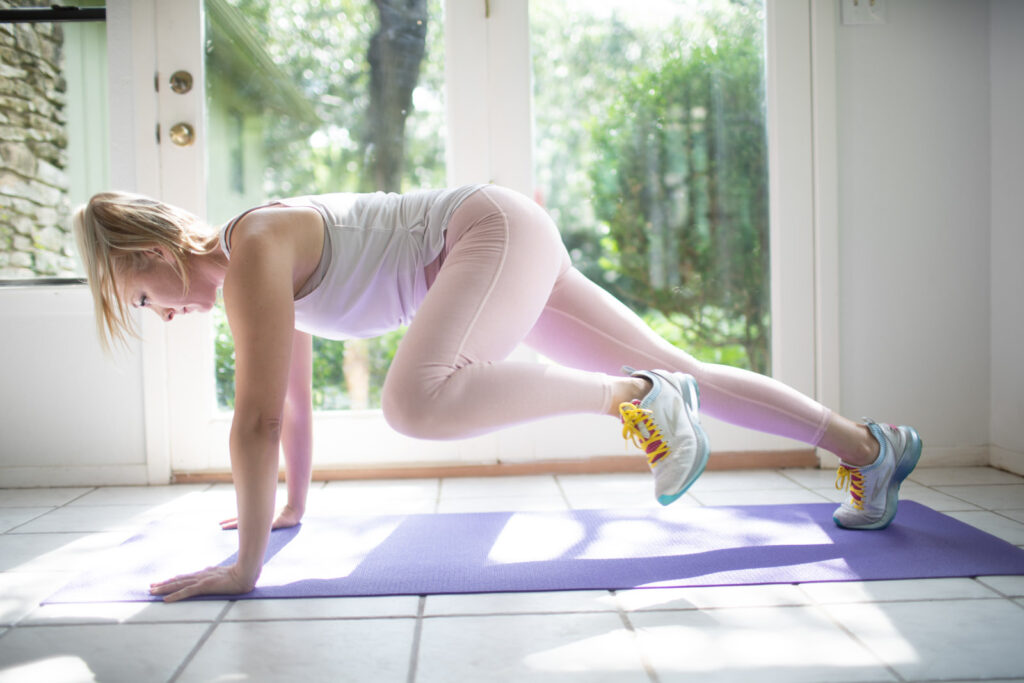
Bicycle Crunches
- Lay on your back with your hands by your ears and knees bent at 90 degree
- As you extend your right leg, reach your right shoulder toward your left knee
- Alternate, so as you extend your left leg, your right knee bends
- Crunch to bring your left shoulder toward your right knee
- Continue alternating, bending your legs as if you’re riding a bike, and doing an oblique (side) crunch on the same rhythm
How To Implement These Simple Core Exercises At Home
I suggest picking one of these sessions to do at a time. Let’s say you’re going to do the A session, which is more abdominal focused. Do the exercises in order, about 10 each. Then move immediately to the next exercise. Rest as you need, but push through a little burn. You got this
At the end of the first round, you will have done 10 each of crunches, alternating toe touches toe touches, Russian twists, V ups, dead bugs, and reverse crunches. Whew! Rest and breathe for about 2 minutes. And then do it again!
You do have options though: if this is your first time doing ab work in a while, you can do one round and see how your abs respond the next day. Aim for proper form and learning the exercises, rather than crushing yourself or rushing through the exercises. Then the next time you do the session, do 2 or 3 rounds.
As you go, you might even time the work sets. Don’t time it for a goal of how fast you can go, but time it for observational purposes. This will help when you are planning out your session, and it will help with motivation to do another round.
Related: here’s a great leg and glute home workout. Check it out!
Most times, big rounds like this look intimidating, but actually only take a few minutes. After you have rested a couple minutes, you can often do another set, even if it seems really challenging.
Apply this same rep scheme and strategy to the B session, the core session. When you are ready, you can alternate these sessions, doing the A session one day, and the B session the next.
As you go, challenge yourself to do more rounds, more reps, or just continue focusing on controlled quality reps. Learning and practicing optimal and proper form is crucial.
Need a bonus ab exercise? This one requires a band and is tough!
This list is 10 of the best ab exercises. Many of these will be familiar.
Who Are these Core Workouts For?
Everybody!!! Whether you are a freelance writer in Austin or a business executive in New York City or a surfer in California, building and abdominal strength and a stronger core will help with your everyday life. Abdominal work can improve posture, improve and prevent lower back pain, and make your daily life more pleasant. Add these into your workout routines once or twice a week and see how it benefits the rest of your training!
Some of these might seem like beginner moves, and they are accessible to beginners! But they are not only for beginners. As you get more advanced in your lifting, you will find you are able to do the exercises better by recruiting more muscle fibers. Basically, you’ll do a better job. And, these simple core workouts at home are equipment free and easy to practice.
For this reason, I suggest you keep working the basics. You can include many exercises. Don’t get caught up in which are the best ab exercises or the best core-strength exercises. As long as you can do them pain free, most any exercise can be a great exercise when done well.
Try These Simple Core Workouts At Home
And let me know how it goes! I’d love to hear!
If you are in the market for some specific exercise guidance (for abs or the rest of your body!) planned for you, let’s do a free consult to talk about training. If you are looking for an Austin personal trainer, I am here! But, I have a fantastic online personal training system, so I’d be happy to work with you wherever you are.
Message me here if you are interested.
Happy ab & core training!!
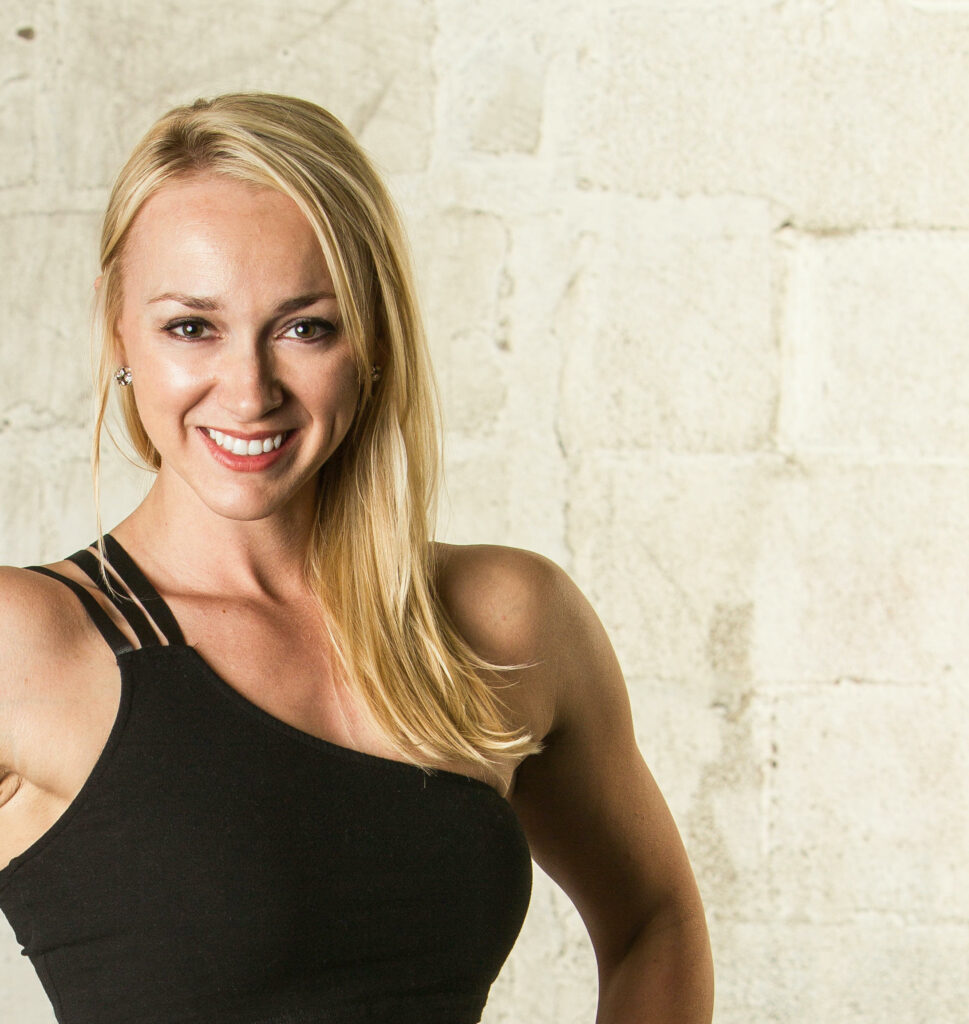
About the author
Kathryn Alexander is a strength coach and personal trainer in Austin, Texas. She loves hiking, college football, and the feel of a perfectly knurled barbell. Read more about Kathryn here.





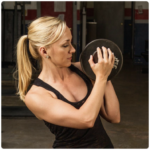


I’ll definitely be implementing some of these tips, thanks for the great advice.
Thanks so much, Jordan! Let me know how it goes for you!